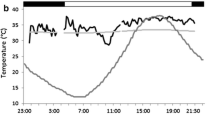Abstract
We used published results from studies in Africa to test the hypothesis that the timing of parturition in the Chiroptera is constrained by rainfall. Comparison of year-round rainfall and insect data at various latitudes showed that insect abundance peaks approximately a month after peak rainfall. A similar comparison of parturition time to rainfall showed that with the possible exception of the molossids, the Microchiroptera commonly give birth a month before peak rainfall. With an average 6-week lactation period in the Microchiroptera, the timing of parturition is such that young bats are weaned just before the period of maximum insect abundance. We suggest that the needs of the young in this post-weaning period may be more important than the energetic demands of lactation on the mother in determining the timing of parturition on an evolutionary scale. A similar conclusion is implied for the African Megachiroptera, but there is insufficient information on their reproduction to adequately test the main hypothesis for these bats.
Similar content being viewed by others
Author information
Authors and Affiliations
Additional information
Received: 4 October 1996 / Accepted: 14 March 1997
Rights and permissions
About this article
Cite this article
Cumming, G., Bernard, R. Rainfall, food abundance and timing of parturition in African bats. Oecologia 111, 309–317 (1997). https://doi.org/10.1007/s004420050240
Issue Date:
DOI: https://doi.org/10.1007/s004420050240




